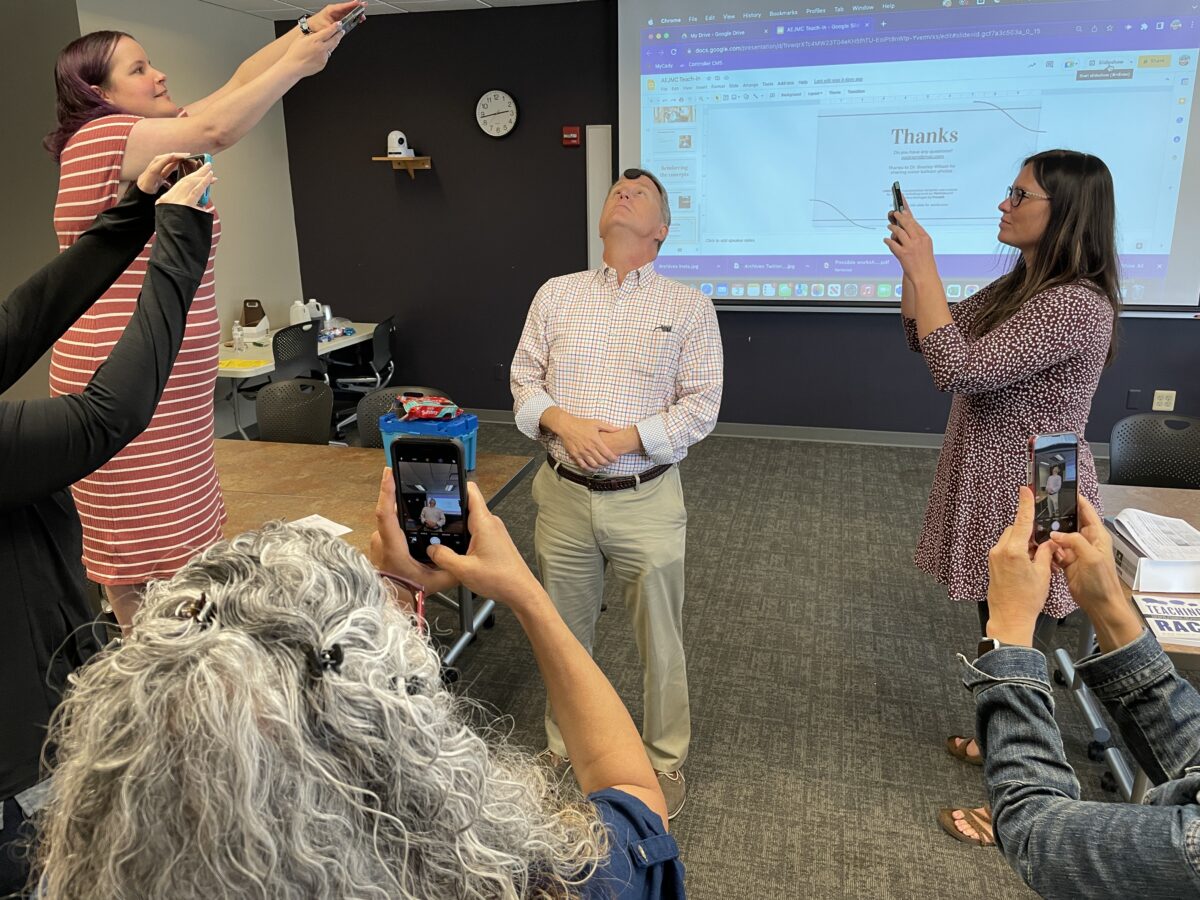‘Journalism hasn’t been sustainable for all voices and all people’
When Candace Perkins Bowen and Julie Dodd dreamed up the idea of the Teach-In, it was an idea to connect with local scholastic journalism teachers and to provide them with free sessions on timely topics.
The day before the Association for Education in Journalism and Mass Communication in Detroit, the 2022 Scholastic Journalism Division Teach-In continued the tradition that is about 13 years old.
Sustainability

Considering Sustainability Thinking to Strengthen Care-Based Pedagogy by Patrick Johnson
DESCRIPTION: When we think about course design, we often forget to think about the even bigger picture: who we want students to be when they leave, not simply what we want them to be. This is where sustainability thinking can be used to help improve our curriculum design. By utilizing the five competencies of sustainability in education — sustainability knowledge, systems thinking, social justice, futures thinking, and active citizenship (Brundiers et al., 2021; Nolet, 2015) — we can elevate the virtue of stewardship to a primary force in our pedagogical practices. Centering our curriculum and instruction on the belief that journalism is meant to take care of all of its publics and train future media professions how to serve a more just and caring society.
DISCUSSION: Patrick Johnson, a former high school scholastic media adviser and now graduate student in the School of Journalism and Mass Communication at the University of Iowa, started off the day with a thought-provoking and lively session on introducing sustainability into the journalism classroom or scholastic media environment.
But he didn’t mean sustainability in terms of recycling paper.
“Sustainability doesn’t necessarily mean green. It means how we understand a system and make a system work for all. Is journalism sustainable?” Johnson asked the crowd consisting of both college media advisers and scholastic media advisers.
Johnson answered.
“Journalism hasn’t been sustainable for all voices and all people.”
And he said that if there was a time to challenge our courses and the industry, it is now.
“It is failing people. It is failing itself,” he said.
And he challenged teachers — before they begin writing curriculum, lesson plans or syllabi — to think about making mass media education more sustainable.
“Sustainability isn’t just about the now. It isn’t just about the then. It’s about how do we make a better future.”
He suggested that educators challenge students to design the newsroom that they think they’re going to work in. Get them to futurethink. He also suggested educators focus on how they teach and that they incorporate ideas from experiential learning, service learning, inquiry-based learning, culturally sustained learning and place-based learning into their classrooms. Journalism students can be more active in the local community through these concepts.
Indeed, he introduced a theme that recurred throughout the day — that scholastic and collegiate media will be filling the gaps left by the decline in the professional media.
“Get into your communities. Ask them what they need from you,” Johnson said. “(Students) have to connect back.”
Teaching race
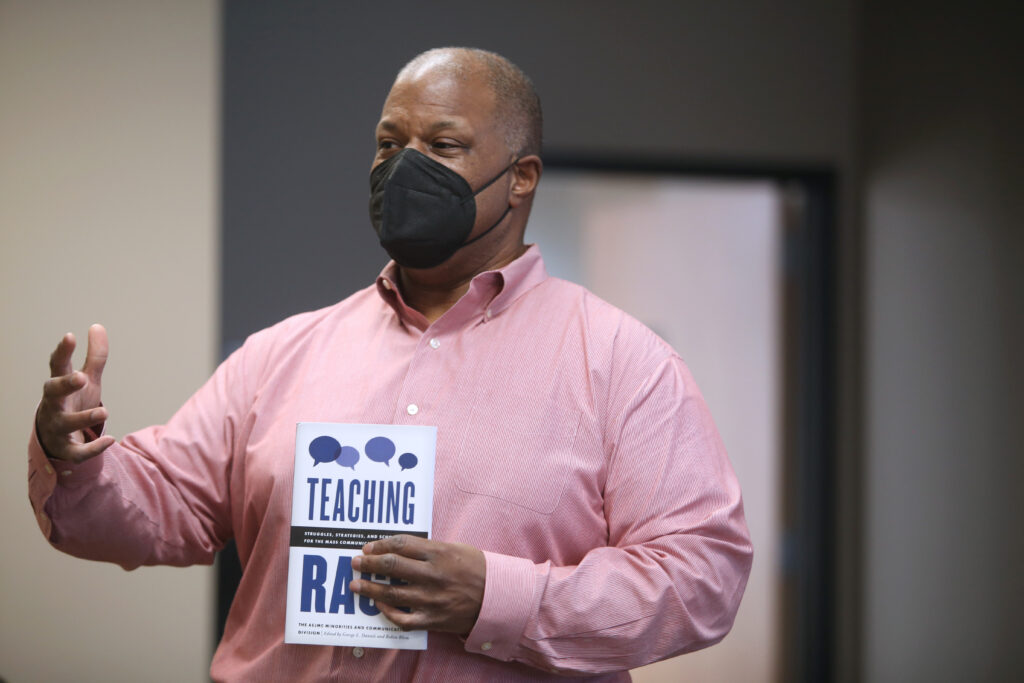
Tips and Tactics for Teaching Race and Teaching Journalism by George Daniels
DESCRIPTION: It’s been called “America’s Rawest and Most Sensitive Nerve.” Race is a topic we can’t avoid if we’re going to tell the whole story. This session offers teachers some strategies middle and high school can use to engage their students before, during and after they cover stories, produce photos or make videos.
DISCUSSION: George Daniels had one key point: educators need to incorporate all kinds of diversity in all aspects of their classes by bringing each student’s individual experience to the class.
“If we start out assuming that everything is about is race, we’d be missing so much,” he said. “I could assume when I see two white males that they don’t have anything to say about race. They’re the problem. If I stopped at just race, I would miss so much.”
To make that happen, Daniels, co-editor of Teaching Race: Struggles, Strategies and Scholarship for the Mass Communication Classroom, said teachers need to have the tools and need to be aware of the political dynamics.
“A lot of our students might not understand the political dynamics. That is really important to bring into the mix,” Daniels said.
Daniels said by thinking about all aspects of diversity, students will find so many more stories. He challenged teachers to get students to write about their own experiences, what makes them different?
“There are many stories in our own experiences.”
Take a time out
Time Out for Diversity by Bradley Wilson
DESCRIPTION: Back in 1999, the Associated Press Managing Editors Diversity Committee with support from the American Society of Newspaper Editors, the Freedom Forum and the Maynard Institute decided they wanted to link diversity and credibility. They wanted to reach beyond editors and into newsrooms to encourage journalists to change the way they look at diversity. This summer, the Journalism Education Association launched a National Diversity Audit. With hands-on exercises, we’ll see how schools can participate in these initiatives to improve their schola stic or collegiate media.
DISCUSSION: Continuing the discussion of diversity in the classroom and tools teachers can use, Bradley Wilson, vice chair of the AEJMC Scholastic Journalism Division, introduced the idea of analyzing actual reporting in media outlets and seeing how the sources in the media correlate with the staff and community.
It’s a four-step process.
- Examine the demographics of the people in the coverage area.
- Examine the demographics of the people on the staff.
- Examine the demographics of the sources used over time in the media outlet.
- Compare the demographics with each other.
Most importantly, Wilson said, this includes, but goes so far beyond, race.
For example, he said that in his study over several years, his student staff members found that their sources looked a lot like them in terms of race, classification, gender and college. However, after being made aware of how they needed a more diverse array of sources, they could make it happen.
“But a student staff could pick whatever categories they want,” he said. “We can change what we measure and track, so it’s important to do pick categories that are measurable and that might result in awareness then change.”
CLICK HERE to download the handout from the winter 2002 issue of Communication: Journalism Education Today.
The real world
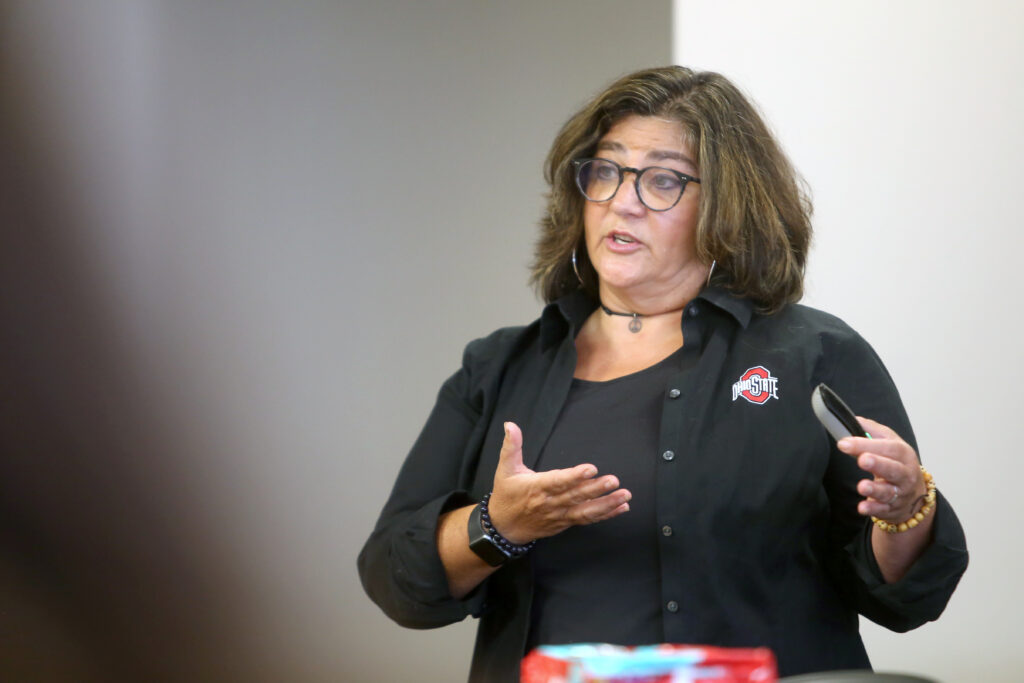
The Real-World Impact of Student Journalism by Nicole Kraft
DESCRIPTION: People may think of student reporters as “journalism lite.” But, in truth, reporters at the high school and collegiate level are dealing with ethical issues that have long-lasting, real-world implications from social justice to global conflict. This session will address the opportunities and challenges students face in pursuing these topics and the important role student-journalists face in the democracy.
DISCUSSION: Nicole Kraft, an associate professor in The Ohio State School of Communication — emphasis on the “The” — wasted no time getting to her point — “There is no real differential now between college or scholastic ethics and professional ethics. There is no student. There is just journalist.”
The issues students face today given the instantaneousness of social media and online publishing as well as the drive to be first are the same as those faced by professional media outlets.
Further, she said, “the words we publish will last forever. Words that live online have a long and everlasting reach.”
However, students are more like reporters in a small town, covering the same people they see at the grocery store and have class with.
So, Kraft said, students need to be introduced to the ethical principles of journalism early and often, through scenarios and real-world examples.
Kraft gave several examples of situations her students at The Lantern found themselves in. Protests. Viral social media. Public records. Student athletes. Take-down requests.
And with each scenario, she reminded advisers that they have a responsibility to teach students what they can do and what they should do.
“We have to make sure that they know what they’re doing.”
Hands-on photography
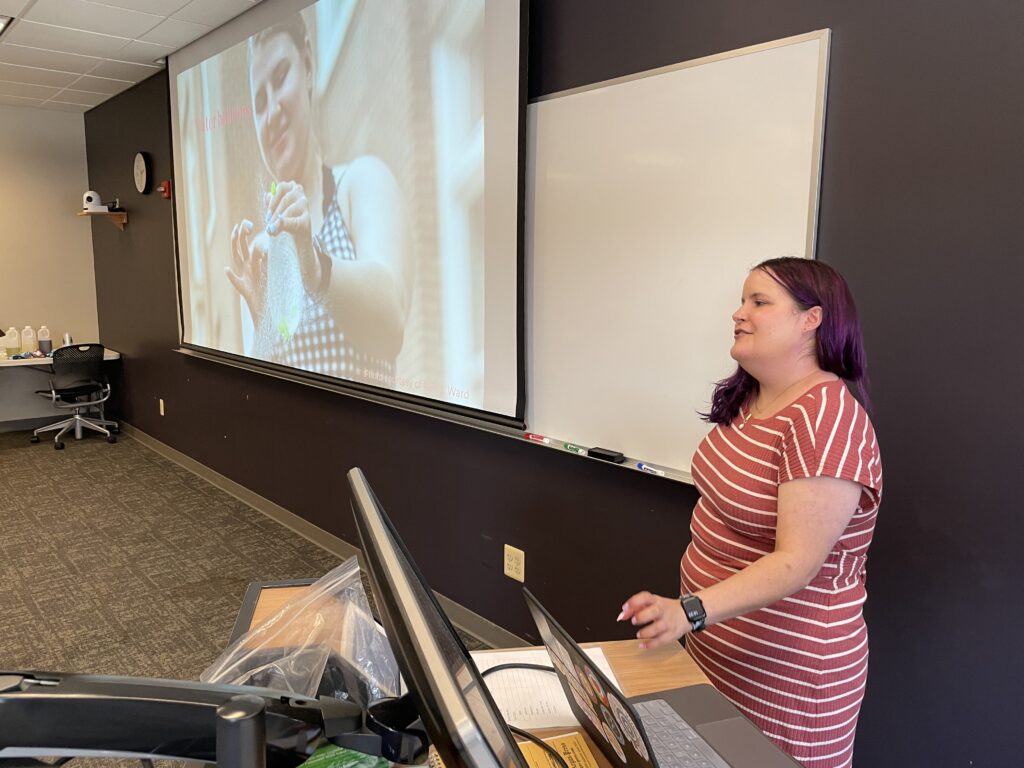
Hands-on: Teaching Photography by Andrea Negri
DESCRIPTION: Teaching photography isn’t just a theoretical exercise. Students need to get their hands dirty outside the classroom or newsroom. Come prepared to have a little fun learning some methods for teaching or reinforcing the basics of photography — even for “non-photographers.”
DISCUSSION: Andrea Negri, recipient of the Scholastic Journalism Division’s Innovative Outreach to Scholastic Journalism Award, developed a curriculum for yearbook company representatives to learn media law.
But that wasn’t why she came to the Teach-In in Detroit, some 1,300 miles from where she teaches in Houston.
At the Teach-In, she got instructors out of their chairs to play with cookies, with toy cars and with water balloons. Actually, she had the water balloons, but that didn’t quite work out. Still, attendees got to toss cookies across the room to practice shooting fast action, got to put cookies on their forehead while moving them down to their mouths only using facial muscles to practice shooting moments, not movies and got to photograph toy cars on a plastic racetrack to practice panning and shooting action.
With each game, she emphasized persistence.
“Persistence is really important in sports photography,” she said.
Advancing reporting skills
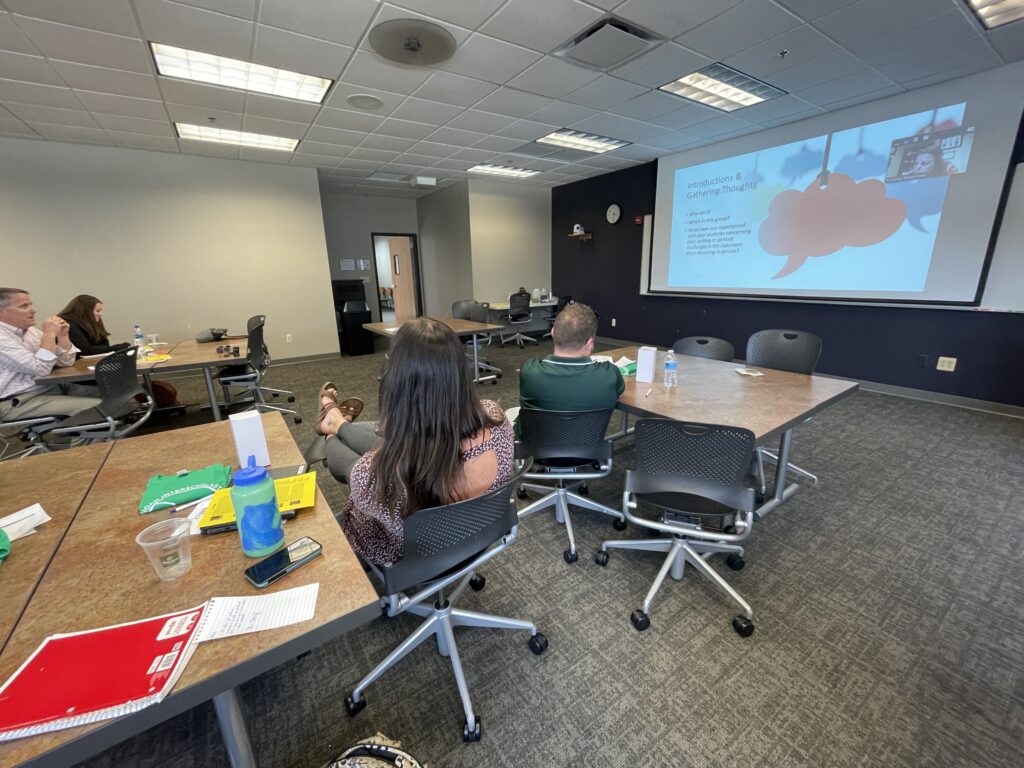
Reinvigorating Writing Skills Post Lockdown by Melanie Wilderman
DESCRIPTION: Now that we are past the pandemic lockdown phase, and with most schools back to some semblance of “normal,” researchers are uncovering so much about how students’ learning was affected by the instability COVID-19 caused. Based on content from several of these studies, we will break down strategies for coaching our students back into the writing mindset while picking up and focusing on skills, both general writing and journalistic, that may have been lost along the way when the country was in survival mode.
DISCUSSION: At the end of the day, Melanie Wilderman appeared virtually from Oklahoma to discuss, first, how students, because of the pandemic, are far behind.
“They’re behind in writing. They’re behind in science too, but there’s nothing I can do about that,” she said. “They’re behind socially, emotionally and academically.”
But, she said, “I’m sure teachers aren’t surprised to hear any of this.”
Although her emphasis was on helping students to improve their writing skills, she acknowledged that before teachers can even begin to assess the work of the students in their journalism classes, teachers probably need to assess the knowledge, skills and abilities in journalism in general of the students.
“I’m often amazed at the students who have decided to major in journalism who don’t read a lot of news and therefore don’t have a good grasp of it,” Wilderman said.
Then she offered some suggestions to help students catch up on their writing skills.
- Make time for short assignments.
- Make time for drafts, revision and rewriting.
- Make writing every day the culture.
- Time for editing in class.
Wilderman said faced with grading sometimes 100+ papers per day, instructors have had to find ways to be more efficient.
“Don’t feel like you need to grade every single piece of writing that you assign. Not everything has to be deeply assessed and then graded,” she said via Zoom. “Spot check. Encourage revision.”
She also encouraged teachers at any level to go to where the student is. Maybe, for some students, maybe that means the student just starts talking with someone else taking notes. Or maybe it means that the student start by using a voice recorder to record the first draft of a story then use software such as otter.ai to transcribe it.
“Writing is not a punishment,” she reminded the group. “(Students) think they don’t need to write. Writing is part of the great bigger category of all human communication. Admit that learning to write well is often difficult.”
Sponsors and hosts
OF THE 2022 TEACH-IN

Bradley Wilson is an associate professor at Midwestern State University in Wichita Falls, Texas. In 2020, the Scholastic Journalism Division of the Association for Education in Journalism and Mass Communication gave him the David Adams Educator of the Year Award. He has received the Gold Key from the Columbia Scholastic Press Association and the Pioneer Award from the National Scholastic Press Association. In 2014, the National Press Photographers Association named him the Robin F. Garland Educator of the Year and the College Media Association named him a Distinguished Adviser for newspaper advising at a four-year college or university. In 2017, he received the Edith Fox King Award for contributions to scholastic journalism in Texas.
